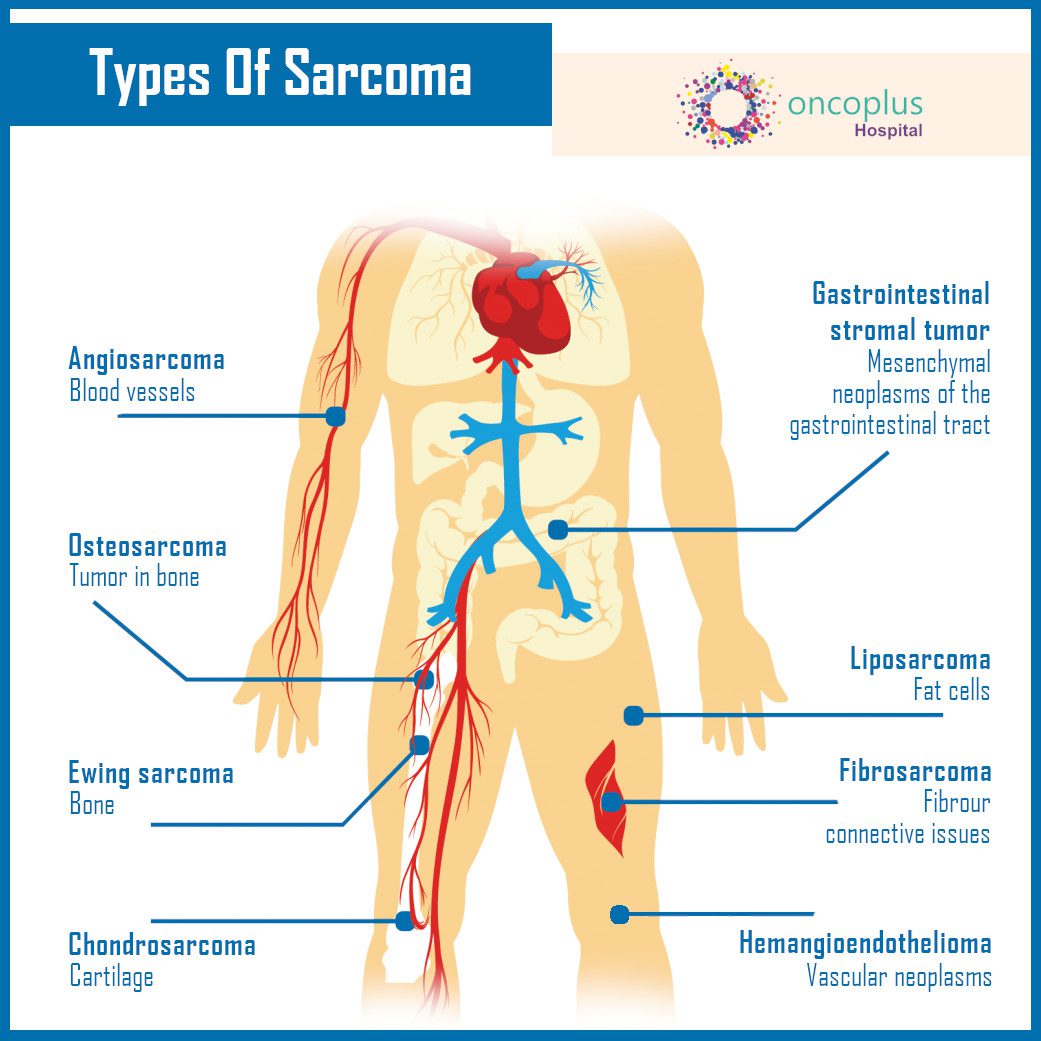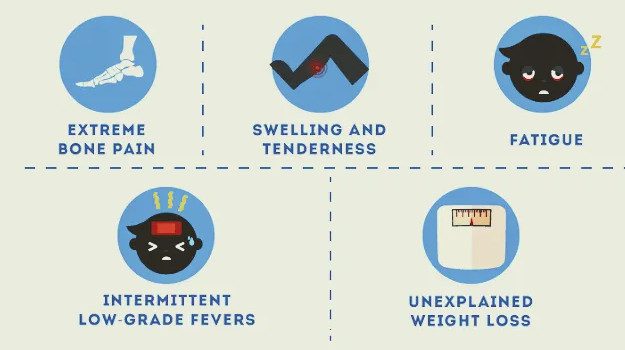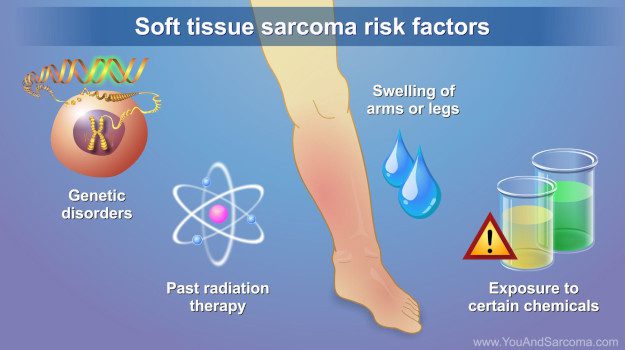Sarcomas are less well-known in the world of cancer than more widespread varieties like breast or lung cancer. Sarcomas, on the other hand, are a class of malignancies that can impact the body’s many tissues, including the bones, muscles, and connective tissues. If you wish to have your regular check-up or treatment for Sarcoma Cancer, you should consult with Oncoplus. We provide expert Sarcoma treatment in Delhi and are known for cancer specialists, the world’s best and most renowned Sarcoma treatment facility.The presence of a lump or tumour might be one of the first indications of sarcoma. But how does a lump caused by a sarcoma actually appear and feel? We will delve into the realm of sarcomas in this blog, looking at their traits and the value of early detection.
Understanding Sarcomas:
Let’s first establish what sarcomas are in order to comprehend better how a sarcoma lump feels and appears. Sarcomas are a rare form of cancer that develops in the body’s connective tissues. These tissues include blood vessels, fat, muscles, tendons, cartilage, and bones. Sarcomas can appear anywhere on the body, which makes it difficult to identify them in the early stages.
Let’s learn about some early detection of sarcoma here:
- The Appearance of a Sarcoma Lump:
The appearance of a lump or mass in the affected area is one of the telltale indicators of a sarcoma. The size, form, and appearance of these tumours can vary. The following are some essential qualities to consider:
- Size: Sarcoma lumps can range in size from tiny nodules the size of a pea to more pronounced masses.
- Texture: Depending on the type of tissue affected, the texture of a sarcoma lump might be soft and mushy or hard and bone.
- Surface: Some sarcoma lumps may be smooth, while others may have an uneven or lumpy surface.
- Colour: Changes in skin colour are often not linked to sarcoma tumours. Subcutaneous protrusions are how they frequently appear.
Remember that not all lumps are malignant and that numerous benign illnesses can also result in lumps. However, a medical professional should be consulted right once if an unexplained lump persists or increases.
Read More Blog : ETV6 Protein Could Be An Important Target For Ewing Sarcoma Treatment
- Pain and Discomfort:
In addition to the sarcoma lumps outward appearance, people with sarcomas may also experience pain or discomfort in the affected location. The discomfort may be continual or sporadic and range in intensity from mild to severe. While some people say they feel a deep, agonising ache, others may feel sharp or shooting sensations.
It’s critical to distinguish between typical aches and pains and the agony brought on by a sarcoma. It’s critical to see a doctor if a lump is present along with persistent, inexplicable pain.
- Changes Over Time:
Another factor making early detection so important is the fact that sarcoma tumours can change over time. These modifications could involve:
- Shape: The lump’s shape may deteriorate or vary in contour.
- Texture: The lump’s texture may change to be tougher or softer.
- Pain: The type or degree of the pain may change over time.
Do not be reluctant to seek medical advice from a professional for additional evaluation if you observe any of these changes in a lump or mass on your body.
- Location Matters:
The precise position of a sarcoma tumour can yield valuable information. Sarcomas can develop in a number of locations on the body, including:
- Extremities: Sarcomas in the arms or legs are relatively common in the extremities. They frequently feel like lumps in the muscle or under the skin.
- Trunk: Sarcomas in the torso or trunk may appear as deep lumps that are more difficult to spot.
- Head and Neck: Sarcomas in the head and neck area can present as visible or palpable lumps or masses.
- Retroperitoneum: Although retroperitoneal sarcomas are not always perceptible from the outside, they can nonetheless be painful or uncomfortable.
Early Detection and Diagnosis:
Early diagnosis of sarcomas is essential for more successful treatment. Do not put off getting medical help if you discover a lump or any of the related symptoms. To confirm the diagnosis, your healthcare professional will do a thorough evaluation that may involve imaging tests like X-rays, CT scans, or MRI scans.
Treatment Options:
Depending on the kind, location, and stage of the malignancy, sarcomas are often treated using a multidisciplinary approach that may include surgery, radiation therapy, and chemotherapy. Plans for treatment are customised for each individual’s unique circumstance because sarcomas can differ greatly.
In determination, sarcomas are an uncommon but deadly type of tumour that can affect a variety of bodily tissues. Sarcoma lumps can have a wide range of appearances and sensations, which makes early detection difficult. But knowing the essential traits of these lumps, keeping an eye out for changes over time, and getting a quick medical check-up can save a life. Keep in mind that not all lumps are dangerous, but when it comes to your health, it’s always better to err on the side of caution. For a complete assessment and diagnosis, speak with a healthcare provider if you are worried about a lump or encounter any related symptoms.
The keys to effectively managing sarcomas and increasing the likelihood of a satisfactory result include early identification and prompt treatment.Oncoplus is recognized as one of the best cancer hospitals in India. It is renowned for its top-notch oncology surgeons in Delhi, research, and holistic approach, including both conventional and cutting-edge cancer treatment options. Patients choose Oncoplus as their go-to cancer specialist hospital in Delhi because of our knowledgeable staff of cancer specialists.
Ewing sarcoma is a rare, aggressive form of bone cancer primarily affecting children and young adults. The disease is named after Dr James Ewing, who first described it in 1921. While chemotherapy and radiation therapy can be effective in treating Ewing sarcoma, many patients experience relapse or resistance to these treatments, highlighting the need for new therapeutic targets. Recent research has identified the ETV6 protein as a potential target for Ewing sarcoma treatment. In this blog, we will discuss about Ewing sarcoma, its symptoms, treatments and how ETV6 protein can be an essential target for Ewing sarcoma treatment in Delhi, India.
What is Ewing Sarcoma?
Ewing Sarcoma is most commonly found in children and young adults and is often diagnosed in people between the ages of 10 and 20. Children and teenagers are more likely to develop the rare bone and soft tissue cancer known as Ewing sarcoma, sometimes referred to as Ewing’s sarcoma and Ewing tumour. When the DNA in some cells alters, aberrant cells that attack healthy tissue are created, leading to Ewing sarcoma. More information about the relationship between cell alterations and Ewing sarcoma is being discovered. New Ewing sarcoma treatments are being tested in clinical trials because of this research, and these trials may be beneficial for young patients with Ewing sarcoma.
Symptoms of Ewing Sarcoma:
Symptoms of Ewing Sarcoma can vary depending on the location of the tumour but can include:
- Discomfort or inflammation in the affected area.
- Difficulty moving the affected limb.
- A noticeable lump or mass.
- Fever or fatigue.
- Unexplained weight loss.
- Bone fractures that occur without a significant injury.
- For a correct diagnosis, it’s crucial to consult a doctor as soon as you can if you or someone you know is exhibiting any of these symptoms.
Ewing Sarcoma Treatments:
Treatments for Ewing Sarcoma typically involve a combination of chemotherapy, radiation therapy, and surgery. The specific treatment plan will depend on the size and location of the tumor, as well as the stage of the cancer.
Chemotherapy is often the first line of treatment and involves the use of drugs to kill cancer cells. The tumour is reduced in size and any leftover cancer cells are eradicated with radiation therapy. Surgery may be necessary to remove the tumor or affected bone, and can be followed by reconstructive surgery if necessary. In some cases, a stem cell transplant may be recommended after chemotherapy or radiation therapy to help restore the body’s blood cells and immune system.
Overall, early detection and prompt treatment are crucial for improving outcomes for those with Ewing Sarcoma. If you have concerns or questions about Ewing Sarcoma or any other health condition, it is important to speak with a qualified healthcare provider.
What is ETV6 Protein?
ETV6 is a transcription factor, a protein that regulates the expression of other genes. It is involved in a variety of cellular processes, including cell proliferation, differentiation, and apoptosis. ETV6 has been implicated in several types of cancer, including leukemia, lymphoma, and solid tumors such as prostate cancer and breast cancer. However, its role in Ewing sarcoma has only recently been discovered.
In a study published in the journal Cancer Cell, researchers found that ETV6 is essential for the growth and survival of Ewing sarcoma cells. The researchers used CRISPR-Cas9 gene editing technology to disrupt the ETV6 gene in Ewing sarcoma cell lines. They found that when ETV6 was knocked out, the cells stopped proliferating and underwent apoptosis, a process of programmed cell death. These results suggest that targeting ETV6 could be an effective strategy for treating Ewing sarcoma.
The researchers also investigated the mechanism by which ETV6 promotes Ewing sarcoma growth. They found that ETV6 regulates the expression of genes involved in several key cellular processes, including cell cycle progression, DNA damage repair, and metabolism. By controlling these processes, ETV6 enables Ewing sarcoma cells to survive and proliferate in the hostile environment of the tumor microenvironment.
The researchers further demonstrated the therapeutic potential of targeting ETV6 in Ewing sarcoma by using a small molecule inhibitor called TK216. TK216 was designed to block the interaction between ETV6 and another protein called RNA polymerase II, which is involved in the transcription of DNA into RNA. The researchers found that TK216 inhibited the growth of Ewing sarcoma cells in vitro and in vivo, without affecting normal cells. Importantly, TK216 also showed synergy with standard chemotherapy drugs used to treat Ewing sarcoma, suggesting that it could be used in combination with these drugs to enhance their efficacy.
In conclusion, the discovery of ETV6 as a potential therapeutic target for Ewing sarcoma is a significant breakthrough in the field of cancer research. The findings of this study provide a foundation for the development of new drugs that target ETV6 and could improve treatment outcomes for Ewing sarcoma patients. The use of TK216, a small molecule inhibitor of ETV6, shows promise as a potential treatment for Ewing sarcoma and warrants further investigation. As more is learned about the role of ETV6 in Ewing sarcoma, it could also serve as a valuable biomarker for diagnosis and monitoring of this devastating disease. With advancements in medical technology and the availability of highly trained oncology surgeons in Delhi patients suffering from this rare form of cancer have access to world-class treatment options.
Sarcomas are uncommon tumours that often arise from bone or muscle. Bone sarcomas and soft tissue sarcomas are the two main forms of sarcomas. These are a group of aggressive cancers that affect the bones and surrounding soft tissues. Resection, or surgical removal, is the primary treatment for these sarcomas, but it is important to monitor the patients after the resection of the bones to check for any signs of recurrence or new malignancies. It has been found in many cases that sarcomas reoccur in patients’ bodies. So, surveillance strategies for sarcomas are very crucial for the patients, but they depend on the tumour-specific biology, tumour location, treatment, and also on the pattern of recurrence of the tumour after STS resection. Oncoplus Hospital is the leading hospital and provides the best sarcoma treatment in Delhi. In this blog, we will learn the different surveillance strategies following resection of bone and soft tissue sarcomas.
Different surveillance strategies follow resection of bone and soft tissue sarcomas.
- Imaging Studies
Imaging studies, such as X-rays, PET/CT scans, and MRI scans, are the primary means of surveillance following resection of bone and soft tissue sarcomas. This follow-up testing helps in detecting local and distant recurrences of STS. It detects the spread of the cancer to other parts of the body. These studies allow doctors to monitor the affected area for any signs of recurrent disease or new malignancies. X-rays can detect bone abnormalities and changes, while CT scans and MRI scans help detect changes in the surrounding soft tissue. If there are any suspicious areas detected during imaging tests, a biopsy may be performed to obtain a sample of the tissue for further testing. This will help determine whether the cancer has returned or if the suspicious area is due to another condition.
- Physical Examination
Physical examination is also a crucial component of post-operative surveillance for patients with bone and soft tissue sarcomas. Postoperative surveillance contains the history and physical examination of the patients every 3 to 6 months for 2 to 3 years, and afterwards it is performed annually. Doctors will typically perform a thorough examination of the affected area, checking for any signs of swelling, redness, or tenderness. This examination can also help detect changes in the affected limb or joint, which may indicate the presence of recurrent disease.
- Blood Tests
Blood tests can also be used to monitor patients following resection of bone and soft tissue sarcomas. These tests can detect markers of disease progression, such as elevated levels of cancer markers. It measures the levels of specific substances in the blood that are associated with different types of cancer. If, in this case, cancer markers are detected, it is a sign of the presence of recurrent disease, and further tests may be needed to confirm the diagnosis.
- Visits to the Clinic for Follow-up
Clinical follow-up visits are an essential component of post-operative surveillance for patients with bone and soft tissue sarcomas. During these visits, patients will meet with their doctor to discuss their progress and receive a physical examination. The doctor may also request imaging studies or blood tests in order to monitor the patient’s condition.
In conclusion, surveillance strategies following resection of bone and soft tissue sarcomas are crucial to the overall treatment plan as they help improve the patient’s health. The combination of imaging studies, physical examination, blood tests, and clinical follow-up visits can help detect any signs of recurrent disease or new malignancies, allowing for early intervention and improved patient outcomes. It is important for patients to adhere to their recommended surveillance schedule and to report any changes or concerns to their doctor promptly. You can visit Oncoplus Hospital, the best cancer hospital in Delhi, for the treatment of bone and soft tissue sarcomas. Their oncologist has years of experience and uses advanced technology to treat cancer patients to provide the best treatment plan possible.


